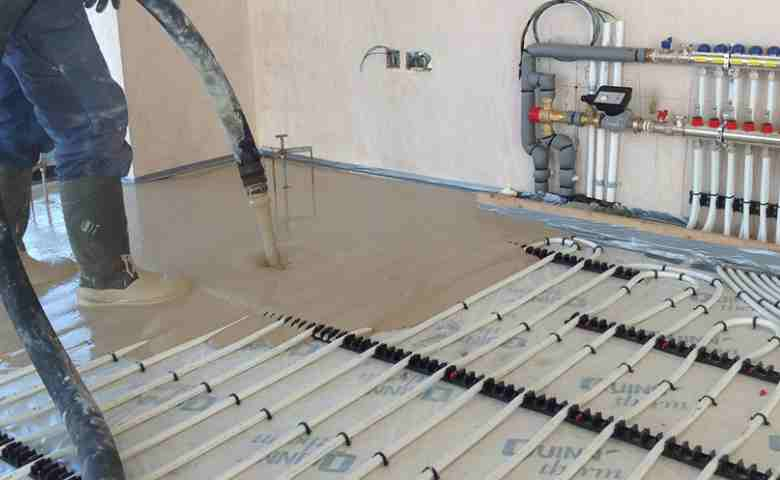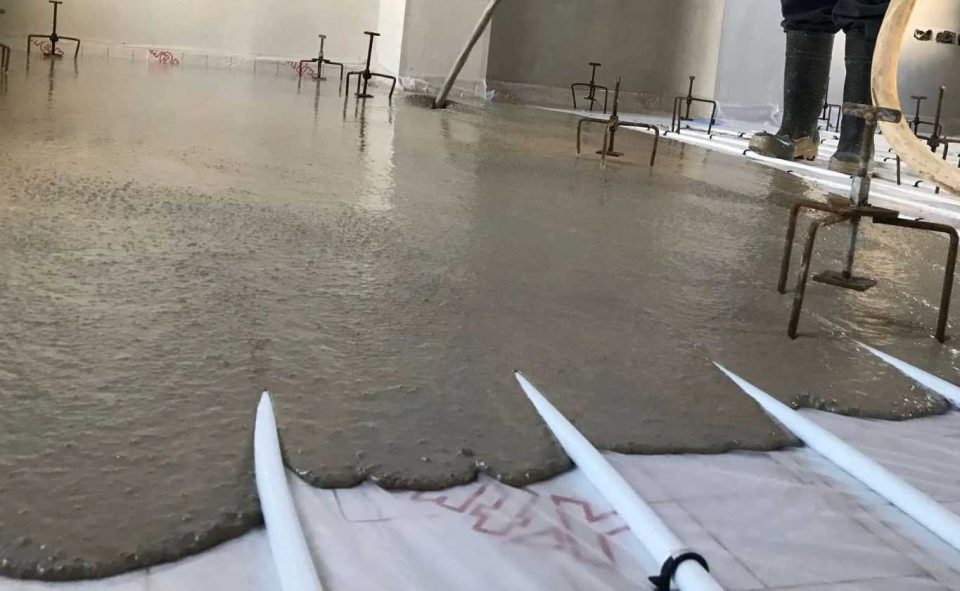Last Updated on April 4, 2024 by Admin
Table of Contents
What is Floor Screed?
A floor screed is a mixture of aggregate, cement and water used to provide a smooth and durable finish to a floor. It requires a relatively simpler and quicker method for installation. That is why it has become extremely popular over the years. It also has lesser final setting time than concrete and can be ready to use much sooner.
Floor screed also requires a thinner layer and offers great thermal conductivity; that is why it is a preferred floor surface for underfloor heating systems.
Different Types of Floor Screed
Dry Screed
It is the most common type of screed that is being used in combination with underfloor heating systems. It is a concrete-like substance made by mixing finely graded aggregates, sand and cement. Owing to its relatively lower workability, it can be used to create uneven surfaces and can be squeezed into different shapes. It is an affordable option and is being used in around 78% of the projects in the UK.
Liquid Screed
As the name depicts, liquid screed is a fluid-like material used to create smooth and even floor surfaces for underfloor heating systems. Its workability allows to pour of a relatively thinner layer of screed as compared to the traditional screed. Liquid screed in London also requires a simpler and quicker installation method and allows you to lay thicker insulation underneath your heating system due to its thinner layer.
What Makes Floor Screed Suitable for UFH Systems?
Floor screed proves its suitability for underfloor heating systems in numerous ways. That is why this combination has become highly popular all across the UK. Some of the perks of this combo are the following:
- It has a thinner layer, which leaves more room for you to add thicker insulation beneath your underfloor heating system and reduce heat losses.
- Its thinner layer offers great thermal conductivity all across the floor, which reduces the hot and cold spots.
- It is compatible with almost all the flooring surfaces, including tiles, wood and carpet. This allows you to choose the best option for you.
- It needs less time to set than the concrete, allowing you to utilise your underfloor heating system sooner.
- It acts as a protective shield to the underfloor pipes and cables and keeps them from getting damaged
Things to Consider Before Screeding Your Floor?
Although floor screed is relatively simpler and quicker to install, a few factors should be considered before starting the process. These factors include the following:

The Type of Screed
Keep in mind that both types of liquid screed possess different characteristics and can serve differently. Hence, make sure to consider your requirements and all other factors to select the most suitable type of floor screed for your project.
Thickness of Screed
This is a particularly important factor that needs to be considered. You will need to install your floor screed in optimum thickness to receive the best performance of your underfloor heating system. Too thick a layer of screed will hamper the thermal transmission, provide less room for insulation and reduce your flooring options as well.
Thickness of Insulation
Insulation is an important component of an underfloor heating system. If you do not install insulation beneath your system, you will suffer from extreme heat losses, which will increase the running cost of your underfloor heating system. Moreover, too thick insulation will reduce the thickness of the screed layer, which can also compromise the performance of the system. that is why it is recommended to properly plan the procedure before commencement.
Expansion Joints
Do not forget to provide sufficient expansion joints to allow the floor to contract and expand under varying thermal conditions. If you do not provide expansion joints, your floor may start developing cracks, which will compromise its structural integrity.
Preparation of the Surface
Ensure that the cables or water pipes of your heating systems are properly fitted and will stay in their place during the procedure. If not, you should take your time to fit them properly in order to enjoy an even heating throughout the space.
Curing
You must provide proper curing time to ensure it achieves its maximum strength. You cannot turn your underfloor heating system too soon. Otherwise, the floor will start to crack under abrupt and extreme temperature changes. It is recommended to cure the floor for 3-4 weeks to gain maximum strength out of it.
K M Flow Screed offers specialist floor-screeding services at highly affordable prices. Contact us, and let’s discuss your project today.
Related posts:
- 8 Must-Have Tools for Concrete Contractors
- Is the Solar Industry Still Growing? 7 Things to Know About Solar Energy and Solar Panels
- How to Calibrate the Paint Thickness Gauge?
- Why is Waterproofing a must before you buy or rent a home?


